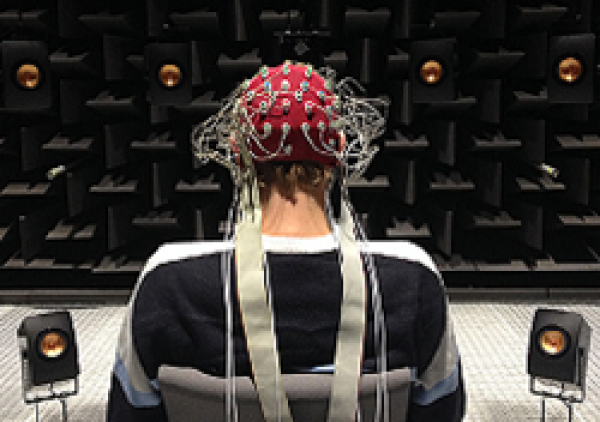This is the first step towards developing a brain-controlled hearing aid.
A hearing aid basically enhances all the sounds in our surroundings. This means, for example, that during a restaurant visit, background noise is increased just as much by a hearing aid as the speech from the person sitting opposite. People with normal hearing can easily distinguish and concentrate on listening to what the person is saying. On the other hand, it’s difficult for a person with a hearing aid, for whom all the sounds are equally amplified.
Using electroencephalography (EEG) measurements with electrodes on the head, researchers at DTU Electrical Engineering have managed to decode the processes in the brain that enable us to differentiate sound and concentrate on, for example, what one particular person is saying.
The measurements have paved the way for researchers to then develop models and algorithms for the process which in future can be used to send the exact sound to the hearing aid that the user wants to hear.
Ambitious goal of brain-controlled hearing aids
The work has been carried out as part of the European COCOHA project (Cognitive Control of a Hearing Aid), in which DTU is participating together with French, English and Swiss universities as well as the hearing aid manufacturer Oticon’s Eriksholm Research Centre.
“The goal of the COCOHA project is to help hearing aid users enhance the sound that they’re focusing on. In other words, cognitive control of the hearing aid, where the listener’s attention controls which signal should be amplified. We’re working with using brain signals to control hearing aids, and after the first few years of research, we’ve managed to show that it is actually possible to achieve such real-time control,” says Jens Hjortkjær, Senior Scientist at DTU Electrical Engineering and Hvidovre Hospital.
The Danish researchers have conducted tests where electrodes on the head of a test person have measured the brain’s activity when the person was asked to concentrate on listening to the voice from person A while ignoring that from person B. The activity in the brain was then used to amplify the sound of person A’s voice and mute the sound from person B and send this to the hearing aid. Being able to hear the sound you want to listen to has been made possible by using the models and algorithms developed in the course of the researchers work to decode the brain processes.
“It’s an exciting step in the development of a new type of cognitively controlled hearing aid that will hopefully help the user to hear more like someone with normal hearing. Other types of cognitive control might include amplifying the sound of the person the user is looking at—for example by registering the user’s eye direction with EEG electrodes,” says Jens Hjortkjær, adding:
“However, it would be ideal if it were possible to control the hearing aid by simply concentrating on the desired sound. This way, for example, you could keep your eyes on the road when driving and at the same time listen to someone talking on the back seat. The attention-controlled device attempts to emulate normal hearing, where the listener is able to follow a specific speaker by simply focusing on the person in question.”
More about the project (in Danish) can be found clicking on the following links:
https://videnskab.dk/krop-sundhed/dtu-droem-et-hoereapparat-der-skruer-op-for-bestemte-lyde-ved-tankens-kraft
https://jyllands-posten.dk/nyviden/ECE10606919/dansk-droem-skru-op-for-lyde-ved-tankens-kraft/
https://www.b.dk/nationalt/banebrydende-forskning-skru-op-for-lyden-med-tankens-kraft
https://www.kamikposten.gl/2018/05/16/ny-viden-om-hjernen-kan-give-bedre-hoereapparater/
http://www.elektro.dtu.dk/nyheder/nyhed?id=383BC9A3-0778-478C-AA9B-B52F5F4AF7C9



